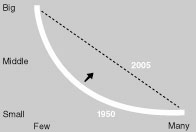FROM PLACES TO SPACES
It takes a village to make a mall.
Community precedes commerce.
The hard middle is a pervasive problem. We have tools to access the ideas in one person’s book: its index and table of contents. We have tools to access the ideas of a library of millions of books: its card catalog. But we don’t have tools to access ideas in the hard middle, the region of expertise in 10,000 scholars, or 1,000 books. Where do you go for a listing of key words, key subjects, and key ideas for the complete literature about the U.S. Civil War?
Until recently, nowhere. Today, the symbol WWW immediately pops into our mind. We see in the World Wide Web the promise of creating a viable midlands. In this particular case the hyperlinking of all documents could be filtered and categorized to generate an index to middle-sized knowledge.

Services and goods for previously ingnored community — and town-sized groups, also known as the hard middle, can make economic sense with network technology.
The electronic space encourages middle communities. Unlike either broadcast or PC chips, a network fosters the energy that flows from the friend of a friend to the friend of a friend. Network architecture can find, cultivate, persuade, manage, and nourish intermediate-sized audiences and communities focused on common interests. Niche markets, in other words. Magazines, rooted in the postal system network, have served niche markets for a century. But the emerging broadband network offers many relationships the postal network (and magazines) could not: spontaneous reply, fully symmetrical bandwidth, true peerage communication, archives, filtering, community memory, etc.

